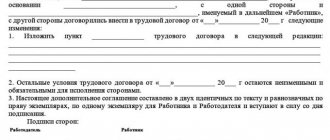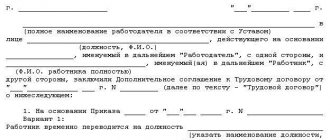In the activities of each structure, situations arise when it is necessary to transfer an employee from one position to another. Such changes happen: due to production needs, as well as on a person’s personal initiative. The translation can be carried out both within one department/department and in various structural divisions of the company. Actions regarding transfer, in connection with a change in the work responsibilities of a subordinate, must be carried out in a certain sequence and with all the required accompanying documents. One of the fundamental documents of the process is an order to transfer an employee to another position. An order is a legal act created only by the director of the company (deputy) to resolve issues of activity or personnel. A sample order for transferring an employee to another position should always be in the organization’s human resources department.
Transfer of an employee
Reasons and reasons
According to the norms of labor legislation, an order for transfer to another job is drawn up if there are reasons and grounds. The main reasons are:
- change of duties of the unit, at the headquarters where the unit works;
- demotion due to staff reduction;
- promotion upon receipt of additional education;
- temporary replacement for another employee who went on vacation, took sick leave or went on maternity leave.
To issue an order, there must be sufficient grounds, of which several may be indicated. The reasons may be:
- certificate of health of the employee;
- memorandum from the immediate supervisor;
- the person’s request for transfer;
- order to reduce staff;
- additional agreement to the employment contract.
Each form that serves as the basis is connected to the order and is stored, in accordance with clause 19 (subsection “b”) of the list approved by order of the Ministry of Culture dated August 25, 2010 No. 558, for 75 years.
Reasons for making a transfer
Temporary transfer to another job
By agreement of the parties, concluded in writing, an employee may be temporarily transferred to another job with the same employer for a period of up to one year, and in the case where such a transfer is carried out to replace a temporarily absent employee, whose place of work is retained in accordance with the law , - before this employee goes to work. If, at the end of the transfer period, the employee’s previous job is not provided, and he did not demand its provision and continues to work, then the condition of the agreement on the temporary nature of the transfer loses force and the transfer is considered permanent. In the event of a natural or man-made disaster, industrial accident, industrial accident, fire, flood, famine, earthquake, epidemic or epizootic, and in any exceptional cases threatening the life or normal living conditions of the entire population or part of it, the employee may be transferred without his consent for a period of up to one month to work not stipulated by the employment contract with the same employer in order to prevent these cases or eliminate their consequences. Transfer of an employee without his consent for a period of up to one month to a job not stipulated by an employment contract with the same employer is also permitted in cases of downtime (temporary suspension of work for reasons of an economic, technological, technical or organizational nature), the need to prevent destruction or damage to property or temporary replacement absent employee, if downtime or the need to prevent destruction or damage to property or to replace a temporarily absent employee is caused by emergency circumstances. In this case, transfer to a job requiring lower qualifications is permitted only with the written consent of the employee. When transferring, the employee is paid according to the work performed, but not lower than the average earnings for the previous job.
Types of translation
As you understand, actions can be done for a certain time or permanently , it all depends on the reason. Let's take a closer look at a temporary transfer ; just like a permanent one, it is qualified by amendments to the employment contract. This type of process is only possible when working with one employer. Also, in some cases, it is possible to issue an order without the permission of a subordinate. There are three classifications:
- Temporary transfer by agreement of the parties. It is carried out with the written permission of the employee and only for a period of up to a year. When a person replaces another staff member, the replacement lasts until that employee takes his rightful place, and the person retains his previous position. When, subsequently, the person’s previous place is not given back, and he remains by his own decision in a temporary position, the temporary transfer loses its force and becomes permanent (Part 1 of Article 72.2 of the Labor Code of the Russian Federation). Only then are the relevant entries entered into the work book. In general, with any temporary transfer, nothing is entered into it; this is stated in clause 4 of the Rules for maintaining and storing work books. Changes are written only on the final translation. Therefore, even a temporary transition that is significant for a career will not be recorded in the document. The opposite situation, when a person, after working part-time in another position, does not want to return to his old position, is not provided for; this is a violation of labor duties, for which the manager has the right to be punished.
Change of workplace for a certain time - Temporary transfers that do not require employee consent. They are considered legal in case of: industrial accident, epidemic and epizootic, natural disasters, during force majeure at work, as well as in cases threatening the lives of citizens (Part 2 of Article 72.2 of the Labor Code of the Russian Federation). Sometimes, translation is appropriate for technical and production downtime, as well as to avoid property damage. During such measures, the employee’s new workplace must correspond to his qualifications, but a shift to a lower vacancy requires consent (Part 3 of Article 72.2 of the Labor Code of the Russian Federation). Transfer of a staff position without its permission is possible only for a month. Also, a person cannot get another job if his health does not allow it. In this case, wages should not be less than the average earnings than in the previous place. If all the above conditions are met, then the person does not have the right to refuse the transition. If management cannot prove the existence of reasons for their actions, the process will be declared invalid (clause 17 of Resolution No. 2). But a person’s refusal to carry out other duties, according to paragraph 19 of the Resolution of the Plenum of the Supreme Court of the Russian Federation, is regarded as a violation of labor discipline, missing shifts after a transfer is absenteeism. It is important to know that a person cannot be punished for refusing to perform new duties if this threatens his health and life, part 7 of Art. 220 Labor Code of the Russian Federation.
Mandatory translations for the employer - Transfers in which the employer cannot avoid making them. These actions occur in the presence of objective circumstances, and other activities should not be prohibited due to health reasons and with written consent. This includes translation in accordance with a medical report (Article 73 of the Labor Code of the Russian Federation). The manager must take into account the period specified in the certificate and only then proceed to further actions. When a person is given a prison term of up to 4 months, the authorities must either provide him with gentle activity for the prescribed period, or remove him from work while maintaining his position. When the form contains a period of more than 4 months or it is not indicated at all, the employee does not have the right to refuse the transfer. If a person does not want to change his workplace, then cooperation with him is terminated under clause 8, part 1, art. 77 of the Labor Code of the Russian Federation - refusal of a subordinate to be transferred to another place, necessary for him according to a medical report. After termination of the contract, the dismissed person is entitled to compensation in the amount of two weeks' average earnings (Part 3 of Article 178 of the Labor Code of the Russian Federation). Additional provisions are provided for persons in higher positions. If managers, accountants, or deputies refuse to transfer, or when the employer does not have a suitable position, the employment relationship is terminated. To legally dismiss, you need to record in writing the refusal of the proposed positions. The Labor Code of the Russian Federation provides provisions for transfers for other categories of citizens. Based on Art. 254 of the Labor Code of the Russian Federation, an employer does not have the right to refuse to transfer pregnant women to another position . Based on the medical report, women in this situation should be transferred to a workplace where production standards are reduced and there are no harmful production factors, while they will retain the average earnings of their old position. While the manager is looking for an appropriate place, the employee is subject to release from work, but she will be paid for missed work hours. The same applies to workers with children under the age of one and a half years.
Sample of temporary transfer to another job
Now let's look at the translation on an ongoing basis . Possible with or without the employee’s consent. If a person refuses, then the process is confirmed by a labor commission or court; if the relevant authorities do not confirm the process, it is considered illegal. The reasons for constant transfers may vary. Let's look at the main ones.
Transfer to another job or position with the same employer . That is, the employee continues to work in his company; his field of activity and a number of points in the employment contract simply change. Although it would be more advisable to sign a new employment contract. Familiarization with the order occurs within three days.
Transfer to work in another area together with the employer . In this case, the employment contract remains in force, but undergoes significant changes, because only the branch of the organization changes. The manager is obliged to notify the subordinate in writing 2 months in advance. If a person resists, he can be fired under Art. 77, clause 9, part 1 of the Labor Code of the Russian Federation with payment of severance pay from Art. 178 Labor Code of the Russian Federation.
Transfer to another employer . This is due to changes in the structure of the company; the process occurs without a break in seniority. Sometimes actions are carried out on the initiative of a subordinate, but this requires the consent of the previous employer. Here the contract is terminated in accordance with Art. 77 Labor Code, clause 5, part 1 of the Labor Code of the Russian Federation. If management refuses, the employee can resign on his own initiative and find a job in the desired organization, but there will be no transfer.
Regardless of what kind of transfer is being carried out, the subordinate must be familiarized with the job description on safety precautions and other local documents against his signature.
Completed employee transfer form
Why do you need a transfer order?
The transfer of a person from one position to another, carried out on an ongoing basis, is subject to reflection in the work book (Article 66 of the Labor Code of the Russian Federation). In turn, an entry in the work book about the transfer must be made on the basis of a separate order (clause 10 of the Rules for maintaining work books according to Decree of the Government of Russia dated April 16, 2003 No. 225).
Data on the temporary transfer are not entered into the work book - but in this case, the order can play the role of a document certifying the fact of the employee’s written consent to the transfer (when he puts a signature on the order confirming familiarization with the administrative document).
Such consent is necessary due to the provisions of Art. 72.2 Labor Code of the Russian Federation. A similar requirement, by the way, is in Art. 72.1 of the Labor Code of the Russian Federation, which regulates translations in general. In addition, in the provisions of Art. 62 of the Labor Code of the Russian Federation provides for the drawing up of orders for transfers, regardless of the duration of work in the new position. The employee has the right to request a copy of any such order from his superiors at any time.
How to make a transfer?
The document can be drawn up arbitrarily or using standard forms T-5 and T-5a, which were approved on 01/05/2004 by the State Statistics Committee of Russia. Until 2013, order form T 5 was mandatory, but then it ceased to be important. However, despite the free templates allowed, most HR managers prefer to use ready-made forms. The forms contain all the necessary details for filling out, prescribed in paragraph 2 of Art. 9 of Law No.402-F3.
Form order T-5 is needed to transfer one staff unit. During a mass transfer, it is more advisable to use the T-5a form, which significantly reduces the company’s document flow. When entering data, the unused form is simply crossed out. The order is filled out by a personnel employee of the enterprise where the process is being carried out. The form is issued in one copy, confirmed by the signature of management and must be brought to the attention of the employee against signature. The sample order for transfer to another position is quite simple, so even a beginner can handle filling it out. The filling itself can be done either by hand or using electronic means of typing and printing.
Transfer of a contract service employee to another position
The contract concluded with an employee of the internal affairs bodies, appointed to a position in the internal affairs bodies, for which rotation is provided, includes a provision on the possibility of transferring the employee in the prescribed manner to another equivalent position, including to another locality, and in case of his refusal - on the possibility of transfer in the prescribed manner to a lower position or dismissal from service in the internal affairs bodies.
The terms of the contract can be changed only by agreement of the parties and in writing, with the exception of cases provided for in Part 1 of Article 35 of the Federal Law of November 30, 2011 N 342-FZ “On service in the internal affairs bodies of the Russian Federation and amendments to certain legislative acts of the Russian Federation”. Federation".
Other employee statements ... For example: Application for transfer to another job at the same enterprise
Transfer procedure
Regardless of the classification of the translation, the clearance process must be followed. Sequencing:
- The employer prepares a memorandum , which will list the reasons for the transfer and the person’s personal data.
- Next, the employer places a resolution on the document.
- Documentarily familiarize the employee with the position.
- A man writes a statement of consent to a new position.
- An additional agreement is drawn up , which will describe the responsibilities, payment, vacancy, etc.
- An order is issued and certified by a person.
- A note is made on the T-2 card upon final translation.
- With thorough translation write down new information in the work book.
Memo on the need for temporary transfer
In what cases can the procedure occur?
An employee is applying for another position due to a vacancy that has opened in the organization. And his competence (work experience, education, professional skills) provide him with the opportunity for such a transfer. For example, a secretary-clerk who has worked in the company for a sufficient period of time and has proven himself to be a competent specialist, having learned about the vacancy of an assistant manager, writes an application for transfer to this position.
The transfer was caused by changes in the company : restructuring, consolidation (sometimes, on the contrary, narrowing of the profile), renaming of positions. In such cases, the transfer of employees, as a rule, is initiated by the management of the organization and is quite formal in nature. The application is attached to the rest of the amended documentation: job description, employment contract, etc. Based on this, the entry in the employee’s work book is also changed.
In the process of working in an organization,
an employee receives a higher education (or a 2nd higher education in a different profile; or improves his qualifications).
And he considers it possible to get a position that corresponds to his current competence. For example, a courier, having graduated from university, wants to be promoted to the position of manager. Or a manager who entered the job with a diploma from the Faculty of Philology receives an additional education in economics. And he applies for a position in the accounting department. Here, in addition to the desire of employees for a promotion, it is important to have available vacancies in the organization.
A transfer to another position is not always associated with career growth. Sometimes, an employee is transferred to a lower position. Example: reaching retirement age or being unable to perform your main job due to health reasons. If the company has vacancies provided for such cases, the employee also writes a transfer application.
How is a competency interview conducted? How to prepare for it? A sample job description for an accountant-cashier is located here.
How to open a construction company? You will find detailed instructions here.
Temporary transfer to other positions is also possible. Practiced in hazardous and hazardous industries during the employee’s pregnancy. Or for health problems that are temporary. Or for family reasons. A nuance is important here: according to labor legislation, the period of temporary transfer must be specified. And after this period, the employer provides the same working conditions. But at the same time, the employee writes a statement again (about transfer to his previous place). If the application is not written, the transfer can be considered permanent.
Filling out the form correctly
Order for transfer to another position within the organization, sample and sequence of document preparation:
- name of the enterprise : filled in exactly with the constituent documents;
- OKPO;
- number and date of the order : serial number and date of filling out the T-5 form;
- transfer to another job from : a date is set when the person begins to perform new functions;
- to : date of completion of activities for temporary transfer, if for permanent transfer then a dash;
- Full name : to be filled in only in the genitive case;
- personnel number : the number assigned to the employee is entered (you can find it in the employee’s personal card);
- translation type : choose what type of translation is used;
- old place of business : name and details of the unit, department and position. When filling out the “Structural division” column, the name of a separate division, as well as a department, workshop, site, etc. can be entered;
- reason : indicates what was the reason for starting the process.
- new place of work : all information about the vacancy, structural unit, salary and bonuses.
- base.
Afterwards, the document is signed by the employer and the person changing the position. This, one might say, completes the process of completing the form required for the transfer of an employee.










